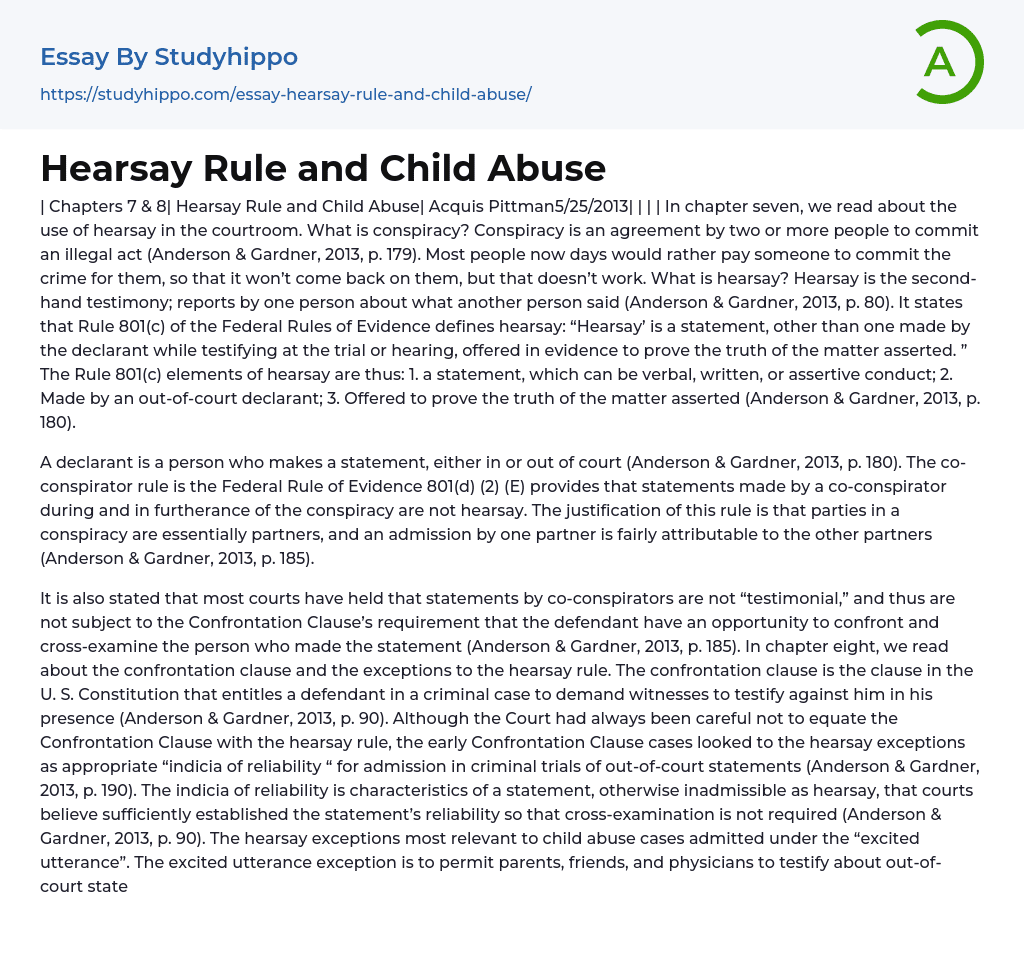What is conspiracy? Conspiracy is an agreement by two or more people to commit an illegal act (Anderson & Gardner, 2013, p. 179). Most people now days would rather pay someone to commit the crime for them, so that it won’t come back on them, but that doesn’t work. What is hearsay? Hearsay is the second-hand testimony; reports by one person about what another person said (Anderson & Gardner, 2013, p. 80).
It states that Rule 801(c) of the Federal Rules of Evidence defines hearsay: “Hearsay’ is a statement, other than one made by the declarant while testifying at the trial or hearing, offered in evidence to prove the truth of the matter asserted. ” The Rule 801(c) elements of hearsay are thus:
- a statement, which can be verbal, written, or assertive conduct;
-
fy;">Made by an out-of-court declarant;
- Offered to prove the truth of the matter asserted (Anderson & Gardner, 2013, p. 180).
A declarant is a person who makes a statement, either in or out of court (Anderson & Gardner, 2013, p. 180). The co-conspirator rule is the Federal Rule of Evidence 801(d) (2) (E) provides that statements made by a co-conspirator during and in furtherance of the conspiracy are not hearsay. The justification of this rule is that parties in a conspiracy are essentially partners, and an admission by one partner is fairly attributable to the other partners (Anderson & Gardner, 2013, p. 185).
It is also stated that most courts have held that statements by co-conspirators are not “testimonial,” and thus are not subject to the Confrontation Clause’s requirement that th
View entire sampleJoin StudyHippo to see entire essay
defendant have an opportunity to confront and cross-examine the person who made the statement (Anderson & Gardner, 2013, p. 185). In chapter eight, we read about the confrontation clause and the exceptions to the hearsay rule. The confrontation clause is the clause in the U. S. Constitution that entitles a defendant in a criminal case to demand witnesses to testify against him in his presence (Anderson & Gardner, 2013, p. 90). Although the Court had always been careful not to equate the Confrontation Clause with the hearsay rule, the early Confrontation Clause cases looked to the hearsay exceptions as appropriate “indicia of reliability “ for admission in criminal trials of out-of-court statements (Anderson & Gardner, 2013, p. 190).
The indicia of reliability is characteristics of a statement, otherwise inadmissible as hearsay, that courts believe sufficiently established the statement’s reliability so that cross-examination is not required (Anderson & Gardner, 2013, p. 90). The hearsay exceptions most relevant to child abuse cases admitted under the “excited utterance”. The excited utterance exception is to permit parents, friends, and physicians to testify about out-of-court statements made by a child. Many states have statutes that define “unavailable” as including emotional stress placed on a child by giving live testimony (Anderson & Gardner, 2013, p. 211). In conclusion, the hearsay rule has a lot of different parts to in.
When it comes to using it in court, you have to make sure that it’s allowed and if not then, you have to figure out how to defend someone without the hearsay rule. I feel that when it comes to any cases that has something to deal with a child,
that the excited utterance should always be in place because kids don’t understand what has happened to them and sometimes they feel that they are in trouble.
References
- Anderson, T. M. , & Gardner, T. J. (2013). Criminal Evidence 8th ed. Belmont: Wadsworth Cengage Learning.
- Jurisprudence essays
- Social Injustice essays
- Juvenile Justice essays
- Abuse Support essays
- Alcohol Abuse essays
- Child Abuse essays
- Physical Abuse essays
- Sexual Abuse essays
- Substance Abuse essays
- Agreement essays
- Business Law essays
- Common Law essays
- Community Policing essays
- Constitution essays
- Consumer Protection essays
- Contract essays
- Contract Law essays
- Copyright Infringement essays
- Court essays
- Crime essays
- Criminal Law essays
- Employment Law essays
- Family Law essays
- Injustice essays
- Judge essays
- Jury essays
- Justice essays
- Lawsuit essays
- Lawyer essays
- Marijuana Legalization essays
- Ownership essays
- Police essays
- Property essays
- Protection essays
- Security essays
- Tort Law essays
- Treaty essays
- United States Constitution essays
- War on Drugs essays




